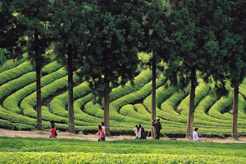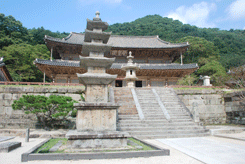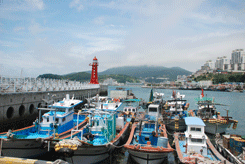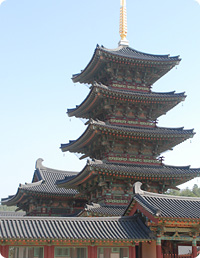EXCURSIONS
Southern Korea (B) 5 days



Tour Highlights
- POW Camp
- Namhae Driver
- Dolsan Park
- Hamel Park
- Nagan Fortress Village
- Hwaeomsa Temple
- Gwanghallu Pavilion
- Haeinsa Temple
- Goryeong Tumuli Museum
- Daegaya Museum
- Seokguram Grotto
- Bulguksa Temple
- Gyeongju National Museum
- Donggung Palace and Wolji Pond
- Banwolseong Fortress
- Cheomseongdae Astronomical Observatory
- Tumuli Parkl
- Yangdongmauel Village
- Gameunsa Pagodas
- Tomb of King Munmu
Click on the days to access the program quick
| Days | Visits and Activities | Distance |
| Day 1 | Busan - Geoje - Tongyeong - Namhae - Yeosu | 280km |
| Day 2 | Yeosu - Nagan - Gurye - Namwon | 140km |
| Day 3 | Namwon - Gayasan - Gyeongju | 270km |
| Day 4 | Gyeongju | |
| Day 5 | Gyeongju - Yangdong - Gampo - Busan | 170km |
Day 1 Busan - Goeje - Tongyeong - Namhae - Yeosu (B) 280km
 Your tour guide greets you in your hotel lobby and takes you on an excursion to Yeosu.
Your tour guide greets you in your hotel lobby and takes you on an excursion to Yeosu.
Today, you will experience the deepest highway on earth, Geoga bridge, a 8.2km-long bridge which is a combination of two cable-stayed bridges built on the open sea, a number of approach bridges and tunnels built on three islands in the middle and a 3.7km-long immersed tube constructed 48m below mean water level.
Geoje is a shipbuilding Mecca featuring several natural harbors. And was once the final port of call of the SS Meredith Victory at Christmas 1950. It is best known for evacuating more than 14,000 refugees in a single mission in the largest humanitarian rescue operation by a single ship during the Korean War.
There’s time to visit the POW Camp which at one time held around 170,000 prisoners in 28 facilities until an armistice was concluded in 1953. The former camp has been reborn as a historic park with various exhibition halls that help visitors comprehend the actual situation at the time and gives visitors an up close lesson on the devastating consequences of the war. POW camp accommodated 150,000 North Korean soldiers and 20,000 Chinese soldiers.
From August 5 to September 6, 1953, under the name Operation Big Switch and Operation Big Swap, both side prisoners were repatriated, at their free choice of destination, at Panmunjeom. The U.N.C. returned 75,823 POWs (70,183 Koreans, 5,640 Chinese); the Communists repatriated 12,773 U.N.C. POWs (7,862 Koreans, 3,597 Americans, 946 British). The vast majority of the 22,600 enemy non-repatriates were Chinese, most of them former Chinese Nationalist veterans. Only 137 Chinese agreed to return to their homeland before the expiration of the ninety-day period stipulated in the armistice agreement. Only 357 U.N.C. prisoners indicated a desire to remain with the Communists (333 Koreans, 23 Americans, one Briton), and of these, two Americans and eight Koreans chose to return within the allotted time for the changing of one's mind. The U.N.C. released all remaining former POWs thereafter, the Communists following suit in a few days later.
Tongyeong is a traditional seaport of great charm and historical interests. Visit Dongpirang village where you will enjoy witty and delightful murals and sweeping view of Tongyeong harbor. This village was on the verge of being torn down, but what were once shabby houses now welcome visitors with radiant colors.
The southern boundary of Korea is a sunken coastline which has created an irregular pattern of bays and inlets. Namhae has long been popular with travelers. The mountains are high and rugged while the scenery is picturesquely rural, offering a pastoral view. The island, comprising 68 both large and small islets, features natural wonders, lovely beaches, ancient temples and historical sites. At the southern tip of the island is one of Korea's most attractive beaches situated below the rugged spires of mountain. There are several little villages placed side by side on the rather steep mountain slopes dropping into the sea.
Your tour stops at German Village set in the beautiful surroundings and inhibited by Korean-Germans who had gone to Germany in the 1960s seeking work and later had returned. Then pass by Gacheon village clinging to the slope. It is more famous for its terraced rice paddies and mysterious phallic symbols.
Day 2 Yeosu - Nagan - Gurye - Namwon (B) 140km
Yeosu itself is nothing special to look at but the natural surroundings offer some spectacular sights along the jagged coastline.
Dolsan Park in the city will offer views to remember. Yeosu is definitely a hidden gem when it comes to scenery. You will have time to see Hamel Park. Dutch sailor Hamel and his seven crew members made their escape from Yeosu after 13 years and 28 days detention on September 4. 1666. Hamel Lighthouse stands tall in a small port and a bit further from the lighthouse is a statue of Hamel. At the fish market, you cannot but help notice the region's abundant resources in terms of seafood and fish resources.
En route, stop at Nagan Fortress Village which has survived time and modernization. Entering the village, you could feel as if you have gone back to the centuries past. Surrounded by 1,410-meter long fortress which was built into a mud rampart in the 14th century to repel Japanese pirate raids, the village features nearly 90 traditional thatched roof houses presenting a peculiar townscape in harmony with the rectangular stone rampart. One unusual aspect of the town is that it was inhabited by a number of different clans rather than having one dominant one. Part of the fortress wall arches over the hill and you will today take in a great view of the entire village as well as the traditional housings, cultural landscape, time old customs and rituals representing the agricultural society of Korea while strolling around the small alleyways within the village.
While in Gurye, explore the 6th century Hwaeomsa. The temple is dedicated to the vairocana Buddha, the cosmic head of the Hwaeom trinity. First, One-Pillar Gate standing at the lower part greets you and leads you up to the second and the third gate - from the secular world into the spiritual world. On the second level, there is the Bojeru, the Save All Beings Hall, beside which stands bell and drum tower and two magnificent 5-story stone pagodas from Silla period. Gakhwangjeon has a double storied roof, and houses seven figures on its altar. Sakyamuni Buddha sits in the middle attended by Amitabha and Prabhytaratna, as well as Avalokitesvara, Samantabhadra, Manjusri, and Ksitigarbha.
Namwon is a charming city with many historical sites and tourist attractions. It is also famous as the home of Chunhyang, the faithful maiden whose story has been often compared to the Romeo and Juliet. At the center of the town is a park, in which stands Gwanghallu pavilion where Chunhyang and her lover are said to have first met, and a bridge, built on a pond that is supposed to ensure connubial bliss to any couple that steps on it.
Day 3 Namwon - Gayasan - Gyeongju (B) 270km
Journey continues to the 9th century Haeinsa. Renounce each of 108 worldly desires of the mind as you climb 108 stairs. Within the Hall of Great Peace and Light, you will see Vairocana Buddha attended by Bodhisattvas and highly detailed and rather unusual wall paintings of the Buddha's life. And on the outside walls are a fair number of paintings portraying Buddhist stories. At the back of this hall is a group of four depositories or Janggyeong Panjeon from the 15th century. Housed within the depositories are 81,258 wood-blocks of Tripitaka Koreana the world's oldest and a complete collection of the Buddhist sutras as well as an offering to the Buddha for national protection from the looming Mongol forces. The printing blocks are some 70cm wide, 24cm long and 2.8cm thick on the average. Each block has 23 lines of text, each with 14 characters, on each side. Each block thus has a total of 644 characters on both sides. Some 30 men carved the total of 52,382,960 characters in the clean and simple style. The characters are perfectly carved as if from the same hand. They were completed in 1251 after 16 years of work on Ganghwado and were transported here for safekeeping. The Mongol forces eventually took over the Goryeo Dynasty but the wooden blocks remain preserved today having survived other invasions, wars and fire. Even more amazing aspect is that neither birds built nests nor spiders make webs on these buildings. Check out two long depositories are designed to have natural ventilation by facing different size windows in the front and rear of the building. Tripitaka Koreana and Janggyeong Panjeon have been designated by UNESCO as a World Heritage for their artistic as well as religious value. In order to control the temperature and humidity within the depositories and protect the Janggyeon Panjeon and woodblocks from fire, full-time security guards and a 24-hour surveillance system are in place.
Visit also includes Goryeong Tumuli Museum featuring a perfect replica of the Jisan-dong Tomb No. 44 itself. And learn about the ancient sacrificial burial custom a funerary practice. About 40 persons were presumably entombed together. Such examples of massive human sacrifice have not been found in other ancient tombs of the era of the Three Kingdoms. Visit also includes Daegaya Museum exhibiting a huge collection of artifacts excavated in Goryeong.
Gyeongju is an ancient capital of the Silla dynasty (BC57-AD935), often dubbed as Museum without Walls. Today, you are treated to one of the ten most historically significant sites in the world with ancient temples, weathered stone pagodas, royal tombs, Buddhist bas-reliefs, and fortress ruins.
Day 4 Gyeongju (B)
With a full day to explore the delights of UNESCO World Heritage Site, Seokguram grotto. It is the home of the serene stone Buddha of the eighth century. Inside, a white statue of a seated Buddha in a sublime state of enlightenment, is surrounded by 37 relief figures of Bodhisattvas, disciples, devas, and guardian kings. The grotto represents the magnificent harmony of religion, science and the arts of Buddhism, symbolizing the pure land in which Buddha resides.
A short ride leads you to another UNESCO World Heritage Site, Bulguksa temple, where you will witness the impressive gates, symbolic bridges leading up to the world of Buddha, graceful architectures, Three-storied Seokgatap and highly ornate Dabotap blending well into the architectural harmony.
At Gwaneumjeon hall, check out the image of the Avalokitesvara who is referred to as the Bodhisattva of Compassion and has a thousand hands, and eyes in each so as to reach out to those in need of help. You will see a gilded statue of Vairocana with the gesture of the first wisdom, Sakyamuni Buddha attended by two bodhisattvas along with sixteen figures of Buddha's disciples sitting in deep meditation, and a gilt-bronze Amitabha Buddha, the ruler of the Western Paradise Sukhavati. The architectural design of Bulguksa is one of constrained dignity, peace, and harmony and the temple still remains one of the most remarkable achievements of the ancient Far East
The Gyeongju Historic Areas contain a remarkable concentration of outstanding examples of Korean Buddhist art, in the form of sculptures, reliefs, pagodas, and the remains of temples and palaces from the flowering, in particular between the 7th and 10th centuries, of this form of unique artistic expression
Visit Gyeongju National Museum. The first thing that you will notice is The Bell of King Seongdeok, the largest extant bell in Korea. You must certainly stand in awe before the bell from the 8th century with such artistic beauty of design. The bell is distinguished not only for its outstanding beauty but also for its long reverberating sound, the incredibly precise casting technique, in addition to the sad legend surrounding it. On entering the museum, you will marvel at the priceless archaeological and historical artifacts including splendid gold crowns, earrings, belts, ornaments, glassware, potteries, and clay figures as well as a royal barge.
Afterwards, explore Donggung palace and Wolji pond, a pleasure garden built to commemorate the victory of Silla, and later used as the recreational area for the Silla's royal family, then followed by the tour of the world's oldest existing astronomical observatory, Cheomseongdae. Each stone used in the observatory bears symbolic meaning; the same number of the days of the year by lunar calendar, the number of the major stars, the months of the year and the numbers of the seasonal divisions. Nearby Tumuli Park encompasses 23 huge tomb mounds where Silla rulers were buried. One of the tombs, Cheonmachong, is opened to the public and you can go inside and see how the tombs were made and replicas of the treasures excavated in 1973.
Day 5 Gyeongu - Yangdong - Gampo - Busan (B) 170km
You will explore UNESCO World Heritage Site, Yangdongmaeul, a delightful journey to the traditional clan village which embraces simple, unadorned natural beauty. There are some steep hills to climb but also easier streets. Over 150 homes as well as two shrines are in perfect harmony with the natural topography, presenting different angles where walls ascend a hill interspersed with tiled roof houses or thatched roof buildings.
On the way, stop at Gampo to see ancient Tomb of King Munmu and twin pagodas. About 200 meter off the coast is an unusual underwater tomb of King Munmu. The king wished his body to be burned and buried at sea so he can protect his kingdom even after his death as a spirit of the sea. In the center of the calm sea a large rock marks the king's burial site. About 20m long rocky islet has a small pond at the center and at the bottom of it is a granite stone of 3.6m long, 2.9m wide and 0.9m high. At low tide, the top of this oval rock is almost visible above the sea surface.
On the nearby ancient temple site stands twin pagodas dedicated to the Dragon Spirit of King Munmu. The immense pagodas are considered the largest 3 story pagoda in Korea, and the temple is one of the most unusual of all Silla temples.






